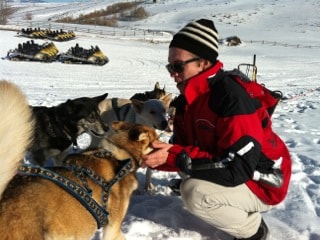Wintry Dangers Are Not Always Predictable
Last reviewed on ovember 25, 2015
In keeping with my New Year’s resolution to include more spontaneous activity with my dog (see Make 2012 Your Pet’s Best Ever, With Three Reasonable New Year’s Resolutions), a recent hike on a sunny and warm January day made me greatly appreciate the fact that Cardiff and I no longer have to endure the annual harsh wintry climate.
Having been an "east coaster" for the majority of my life, I empathize with the discomfort and inconvenience experienced by people and pets residing in seasonally frigid locales. I also recognize the potential danger winter holds for dogs, cats, and other companion animals.
How can your pets thrive this winter despite Mother Nature and man’s contributions to the seemingly continuous seasonal assault? Owners must proactively protect pets from the many hazards associated with freezing temperatures and other environmental changes. Prevention is the best means of keeping your pet from suffering winter’s many hazards.
Cold, Hypothermia, and Frostbite
Winter brings dark days and chilly temperatures capable of causing hypothermia or frostbite, both of which require immediate veterinary care.
Hypothermia is a below normal reduction in body temperature. As compared to humans, pets have a higher range of normal temperatures, ranging from 100-102.5 +/- 0.5.
Core temperature reduction associated with hypothermia decreases blood flow to the extremities (feet, ears, skin, etc.) in order to maintain sufficient supply to the vital organs (heart, lungs, brain, kidneys, liver). This slows down a pet’s mobility, reduces tissue oxygenation, and makes the skin feel cold to the touch and to appear pale pink to blue.
Frostbite occurs when the extremities suffer prolonged exposure to extreme temperatures. "Frostbit" tissues start to decompose, become gangrenous, and may need surgical treatment.
Contact between the skin and freezing rain, sleet, snow, or ice permits heat to readily escape from the body. A healthy pelt of hair or an outer coat of water resistant material can repel some of nature’s assault for a limited time.
Never keep a pet exclusively outdoors in inclement weather. Always provide a thermoregulated shelter with comfortable bedding and a fresh hydration station. Water freezes at or below 32 F, so ensure that a bowl shaped ice cube doesn’t become your pet’s only available option for ingestible liquid.
Heat, Burns, and Ventilation
Chilly outdoor temperatures prompt humans to crank up the indoor heat, which has many potential health risks for pets.
Vents, electric blankets, and fireside snoozing spots can cause thermal skin burns. Never permit close or prolonged contact between your pet and such seemingly cozy sources of warmth. Avoid using kerosene and other fuels, as toxic vapors and potential for fire can create safety hazards for both pets and people.
Activation of ventilation units can mobilize dangerous bacteria, mold, and toxic substances. Respiratory, liver, and other organ system damage can occur post-inhalation or ingestion of these agitated particles. Before you turn on the heat, perform routine maintenance and clean filters as recommended by manufacturer guidelines.
Antifreeze (Ethylene Glycol)
This tasty danger presents a year-round pet threat. In preparing for winter, an automobile’s antifreeze is typically changed or refreshed. It only takes a small quantity of antifreeze’s active ingredient, ethylene glycol, to cause life threatening kidney failure.
Antifreeze spillage in pet-accessible locations could attract an exploring tongue for a sample of the sweet tasting substance. Prevent leakage of antifreeze and other toxic substances (oil, engine fluids, etc.) by having your car professionally serviced away from your home. You can also forego conventional antifreeze for pet safe products (Sierra, etc.).
Even if you strive to pet proof your outdoor environment from the dangers of ethylene glycol, a visitor’s car could leave behind an unwelcome green dribble on your driveway. Additionally, a casual stroll through a parking lot may harbor liquid catastrophe. Always walk your pet on a leash under close supervision during wintery outings to restrict access to ingestible toxins.
Salt
Ice, sleet and snow all create hazardous transportation conditions. To manage our drives and walks, humans commonly rely on rock salt, which is toxic to pets’ exterior and interior bodies.
Contact between salt and the skin’s surface causes drying or irritation. Salt ingestion leads to a variety of gastrointestinal problems, including vomiting, diarrhea, and inappetence. Life threatening metabolic and cardiovascular imbalances are associated with electrolyte abnormalities related to salt consumption.
When walking your dog, head for non-salted surfaces. Around your home, use sand or products labeled as safe for pets (Safe Paw, Morton’s Safe-T-Pet, etc.) instead of rock salt.
*
Juvenile, geriatric, and sick animals are less able to efficiently acclimate to or remove themselves from harsh environments than your average, healthy adult animal. Give extra attention to the needs of youngsters, seniors and ailing pets during wintry months. I hope to hear positive pet health reports from everyone this coming spring.

Park City, UT Sled Dog experience during Sundance 2011

Dr. Patrick Mahaney
Image: AnnalA / via Shutterstock
